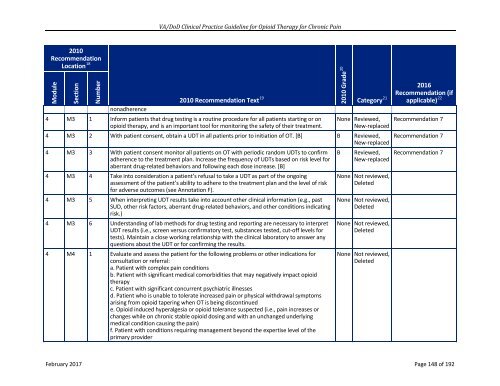VA/DoD CLINICAL PRACTICE GUIDELINE FOR OPIOID THERAPY FOR CHRONIC PAIN
2lfFhbO
2lfFhbO
Create successful ePaper yourself
Turn your PDF publications into a flip-book with our unique Google optimized e-Paper software.
<strong>VA</strong>/<strong>DoD</strong> Clinical Practice Guideline for Opioid Therapy for Chronic Pain<br />
2010<br />
Recommendation<br />
Location 18 2010 Recommendation Text 19<br />
Module<br />
Section<br />
Number<br />
nonadherence<br />
4 M3 1 Inform patients that drug testing is a routine procedure for all patients starting or on<br />
opioid therapy, and is an important tool for monitoring the safety of their treatment.<br />
2010 Grade 20<br />
2016<br />
Recommendation (if<br />
Category 21 applicable) 22<br />
None Reviewed,<br />
New-replaced<br />
4 M3 2 With patient consent, obtain a UDT in all patients prior to initiation of OT. [B] B Reviewed,<br />
New-replaced<br />
4 M3 3 With patient consent monitor all patients on OT with periodic random UDTs to confirm<br />
adherence to the treatment plan. Increase the frequency of UDTs based on risk level for<br />
aberrant drug-related behaviors and following each dose increase. [B]<br />
4 M3 4 Take into consideration a patient’s refusal to take a UDT as part of the ongoing<br />
assessment of the patient’s ability to adhere to the treatment plan and the level of risk<br />
for adverse outcomes (see Annotation F).<br />
4 M3 5 When interpreting UDT results take into account other clinical information (e.g., past<br />
SUD, other risk factors, aberrant drug-related behaviors, and other conditions indicating<br />
risk.)<br />
4 M3 6 Understanding of lab methods for drug testing and reporting are necessary to interpret<br />
UDT results (i.e., screen versus confirmatory test, substances tested, cut-off levels for<br />
tests). Maintain a close working relationship with the clinical laboratory to answer any<br />
questions about the UDT or for confirming the results.<br />
4 M4 1 Evaluate and assess the patient for the following problems or other indications for<br />
consultation or referral:<br />
a. Patient with complex pain conditions<br />
b. Patient with significant medical comorbidities that may negatively impact opioid<br />
therapy<br />
c. Patient with significant concurrent psychiatric illnesses<br />
d. Patient who is unable to tolerate increased pain or physical withdrawal symptoms<br />
arising from opioid tapering when OT is being discontinued<br />
e. Opioid induced hyperalgesia or opioid tolerance suspected (i.e., pain increases or<br />
changes while on chronic stable opioid dosing and with an unchanged underlying<br />
medical condition causing the pain)<br />
f. Patient with conditions requiring management beyond the expertise level of the<br />
primary provider<br />
B<br />
Reviewed,<br />
New-replaced<br />
None Not reviewed,<br />
Deleted<br />
None Not reviewed,<br />
Deleted<br />
None Not reviewed,<br />
Deleted<br />
None Not reviewed,<br />
Deleted<br />
Recommendation 7<br />
Recommendation 7<br />
Recommendation 7<br />
February 2017 Page 148 of 192


